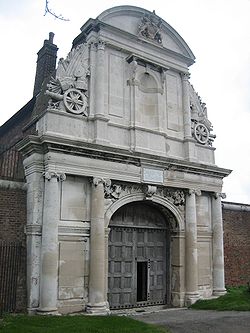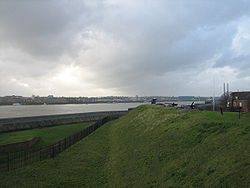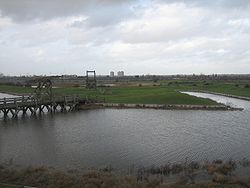
Tilbury Fort
Encyclopedia

Essex
Essex is a ceremonial and non-metropolitan county in the East region of England, and one of the home counties. It is located to the northeast of Greater London. It borders with Cambridgeshire and Suffolk to the north, Hertfordshire to the west, Kent to the South and London to the south west...
, bank of the River Thames
River Thames
The River Thames flows through southern England. It is the longest river entirely in England and the second longest in the United Kingdom. While it is best known because its lower reaches flow through central London, the river flows alongside several other towns and cities, including Oxford,...
in England
England
England is a country that is part of the United Kingdom. It shares land borders with Scotland to the north and Wales to the west; the Irish Sea is to the north west, the Celtic Sea to the south west, with the North Sea to the east and the English Channel to the south separating it from continental...
and was built to defend London
London
London is the capital city of :England and the :United Kingdom, the largest metropolitan area in the United Kingdom, and the largest urban zone in the European Union by most measures. Located on the River Thames, London has been a major settlement for two millennia, its history going back to its...
from attack from the sea, particularly during the Spanish Armada
Spanish Armada
This article refers to the Battle of Gravelines, for the modern navy of Spain, see Spanish NavyThe Spanish Armada was the Spanish fleet that sailed against England under the command of the Duke of Medina Sidonia in 1588, with the intention of overthrowing Elizabeth I of England to stop English...
and the Anglo-Dutch Wars
Anglo-Dutch Wars
The Anglo–Dutch Wars were a series of wars fought between the English and the Dutch in the 17th and 18th centuries for control over the seas and trade routes. The first war took place during the English Interregnum, and was fought between the Commonwealth of England and the Dutch Republic...
. The site is now cared for by English Heritage
English Heritage
English Heritage . is an executive non-departmental public body of the British Government sponsored by the Department for Culture, Media and Sport...
and opened to the public.
History
The first permanent fort at TilburyTilbury
Tilbury is a town in the borough of Thurrock, Essex, England. As a settlement it is of relatively recent existence, although it has important historical connections, being the location of a 16th century fort and an ancient cross-river ferry...
was a D-shaped blockhouse built in 1539 by Henry VIII
Henry VIII of England
Henry VIII was King of England from 21 April 1509 until his death. He was Lord, and later King, of Ireland, as well as continuing the nominal claim by the English monarchs to the Kingdom of France...
and first called the 'Thermitage Bulwark', because it was on the site of a hermitage dissolved
Dissolution of the Monasteries
The Dissolution of the Monasteries, sometimes referred to as the Suppression of the Monasteries, was the set of administrative and legal processes between 1536 and 1541 by which Henry VIII disbanded monasteries, priories, convents and friaries in England, Wales and Ireland; appropriated their...
in 1536. The Tilbury blockhouse was designed to cross-fire with a similar structure at New Tavern, Gravesend. During the Armada campaign the fort was reinforced with earthworks and a palisade and there was a boom of ships' masts, chains and cables stretched across from Thames to Gravesend anchored to lighters. Furthermore, it was in nearby West Tilbury
West Tilbury
West Tilbury is a village situated on the top of a river terrace overlooking the river Thames. The modern town of Tilbury is mainly in the traditional parish of Chadwell St Mary.-Location and administration:...
that Elizabeth I rallied her makeshift army as it awaited the Armada in 1588
The fort was held for Parliament during the English Civil War
English Civil War
The English Civil War was a series of armed conflicts and political machinations between Parliamentarians and Royalists...
and despite suffering from neglect was never attacked by the Royalists. In 1651 its garrison was a governor, a lieutenant, an ensign, four corporals, one drummer, a master gunner, 16 matrosses (gunner's mates) and 44 soldiers.
After the English Civil war Charles II
Charles II of England
Charles II was monarch of the three kingdoms of England, Scotland, and Ireland.Charles II's father, King Charles I, was executed at Whitehall on 30 January 1649, at the climax of the English Civil War...
was exiled in Holland, where he was influenced by European advances in military architecture. Following the disastrous 1667 Dutch attack on the English fleet moored on the nearby Medway, Charles II set in motion the re-fortification of the site by employing Dutchman Sir Bernard de Gomme
Bernard de Gomme
Sir Bernard de Gomme was a Dutch military engineer. By some he is considered the most important figure in 17th century English military engineering.-Early life:...
, who had been engineer in the Royalist army during the civil war and who followed Charles into exile.
Work started on the current fort in 1670 but was conducted slowly, often with the use of pressed labour from nearby towns, and was still continuing in the 1680s. De Gomme's plan was for a pentagon with projecting bastions facing west, north west, north east and east and a planned river bastion facing directly south. Henry VIII's blockhouse was retained. Major features such as the imposing Water Gate were not complete until about 1682. The river bastion never materialised. The resulting structure was "a nationally important example of angular bastioned defences and is the best preserved example" of de Gomme's work.
Besides as the brick fort, there was an earth and brick gunline along the river bank. In 1715 there were 31 demi-cannon
Demi-cannon
The demi-cannon was a medium sized cannon, similar to but slightly larger than a culverin and smaller than a regular 42lb cannon developed in the early 17th century. A full cannon fired a 42-pound shot but these were discontinued in the 18th century as they were seen as too unwieldy. The lower...
and one culverin
Culverin
A culverin was a relatively simple ancestor of the musket, and later a medieval cannon, adapted for use by the French in the 15th century, and later adapted for naval use by the English in the late 16th century. The culverin was used to bombard targets from a distance. The weapon had a...
in the East Gun Line and 17 demi cannon and 26 culverins in the West Gun Line. Two huge powder magazines [housing 3,600 barrels each] were built in the centre of the fort in 1716, but the same year many of the 161 guns surveyed were declared unserviceable and the effective strength was found to be just 60 pieces. In 1724 Daniel Defoe estimated there were 100 guns ranging from 24-pounder to 46-pounder: "A battery so terrible as well imports the consequence of the place".

Battle of Culloden
The Battle of Culloden was the final confrontation of the 1745 Jacobite Rising. Taking place on 16 April 1746, the battle pitted the Jacobite forces of Charles Edward Stuart against an army commanded by William Augustus, Duke of Cumberland, loyal to the British government...
in 1746 who were held at Tilbury. A cricket
Cricket
Cricket is a bat-and-ball game played between two teams of 11 players on an oval-shaped field, at the centre of which is a rectangular 22-yard long pitch. One team bats, trying to score as many runs as possible while the other team bowls and fields, trying to dismiss the batsmen and thus limit the...
match in 1776 between men from the Kent and Essex sides of the Thames allegedly ended in bloodshed when guns were seized from the guardroom; it was reported that an Essex man was shot dead, an elderly invalid was bayonetted and a sergeant was shot trying to quell the riot, but this account is disputed. The Napoleonic invasion scare of 1803 saw the Royal Trinity House Volunteer Artillery manning 10 armed hulks across the Thames at Tilbury.
Nineteenth century improvements in metallurgy and artillery firepower saw extensive re-design and re-modelling along the fort's riverside, much of it overseen by Captain Charles Gordon [1833-85], later known as 'Chinese Gordon or Gordon of Khartoum
Charles George Gordon
Major-General Charles George Gordon, CB , known as "Chinese" Gordon, Gordon Pasha, and Gordon of Khartoum, was a British army officer and administrator....
'. The 17th century walls were reinforced and earth was embanked on the outside to protect the brickwork from the effect of modern high velocity guns. Emplacements were built for 9-inch muzzle-loaders on top of the bastions and these new works became the primary gunline angled more to the south east to engage ships well down stream. The Henry VIII blockhouse was demolished around 1867.

The fort's sole military success was during the First World War, when anti-aircraft guns on the parade ground shot down a Zeppelin
Zeppelin
A Zeppelin is a type of rigid airship pioneered by the German Count Ferdinand von Zeppelin in the early 20th century. It was based on designs he had outlined in 1874 and detailed in 1893. His plans were reviewed by committee in 1894 and patented in the United States on 14 March 1899...
airship. Bombing damage in the Second World War destroyed the 18th century soldiers' barrack block, but the officers' terrace still survives. De-mobilised in 1950 and placed in the care of the Ministry of Public Building and Works and opened to the public, the site is now cared for by English Heritage
English Heritage
English Heritage . is an executive non-departmental public body of the British Government sponsored by the Department for Culture, Media and Sport...
.
The fort has several interesting features. The Water Gate, circa 1682, is an ornate opening in the south wall allowing access to the quay on the river. The outer defences consist of two wet moat
Moat
A moat is a deep, broad ditch, either dry or filled with water, that surrounds a castle, other building or town, historically to provide it with a preliminary line of defence. In some places moats evolved into more extensive water defences, including natural or artificial lakes, dams and sluices...
s, a ravelin
Ravelin
A ravelin is a triangular fortification or detached outwork, located in front of the innerworks of a fortress...
and a redan
Redan
Redan is a term related to fortifications. It is a work in a V-shaped salient angle toward an expected attack...
.
As a result of the 17th century rebuilding, part of the fort was in the parish of West Tilbury
West Tilbury
West Tilbury is a village situated on the top of a river terrace overlooking the river Thames. The modern town of Tilbury is mainly in the traditional parish of Chadwell St Mary.-Location and administration:...
and part in the parish of Chadwell St Mary
Chadwell St Mary
Chadwell-St-Mary is a dispersed settlement in the unitary authority of Thurrock in Essex, England. It is one of the traditional parishes in Thurrock and former civil parish. It is a few miles east of the town of Grays and is located north of the modern town of Tilbury which was part of the parish...
. The officers quarters were in West Tilbury and the other ranks quarters were in Chadwell. Consequently, officers that died were buried in West Tilbury and other ranks in Chadwell.
Surrounding area
The fort lies between the World's End public house (formerly the ferry houseGravesend - Tilbury Ferry
The Gravesend - Tilbury Ferry is a passenger ferry across the River Thames east of London. It links Gravesend and Tilbury, and is the last publicly accessible crossing point before the Thames reaches the sea.-History:see also notes on Tilbury...
) to the west and Bill Meroy Creek
Bill Meroy Creek
Bill Meroy Creek is a small waterway flowing into the Thames to the east of Tilbury Fort in West Tilbury which marked the eastern boundary of the area in which duty had to be paid on coal entering London.-Location:...
to the east. There is a separate fort at Coalhouse
Coalhouse Fort
Coalhouse Fort is a large casemated fort in East Tilbury, near the modern town of Tilbury, in Thurrock, Essex, downstream from Tilbury Fort. It contains a museum of memorabilia from World War I and II.-History of the fort:...
, East Tilbury
East Tilbury
East Tilbury is a village in the unitary authority of Thurrock borough, England and one of the traditional parishes in Thurrock.-History:In Saxon times, the location on which the church now stands was surrounded by tidal marshland...
, which has a Napoleonic and Victorian history. As part of the Tilbury Riverside project, a pathway has been developed between Coalhouse and Tilbury Fort passing along the river bank and past Tilbury Power Station. This is known as the Two Forts Way. The path is just over three miles and is described as "a challenging route suitable for able bodied walkers and experienced cyclists".
External links
51°27′10.00"N 00°22′29.00"E

